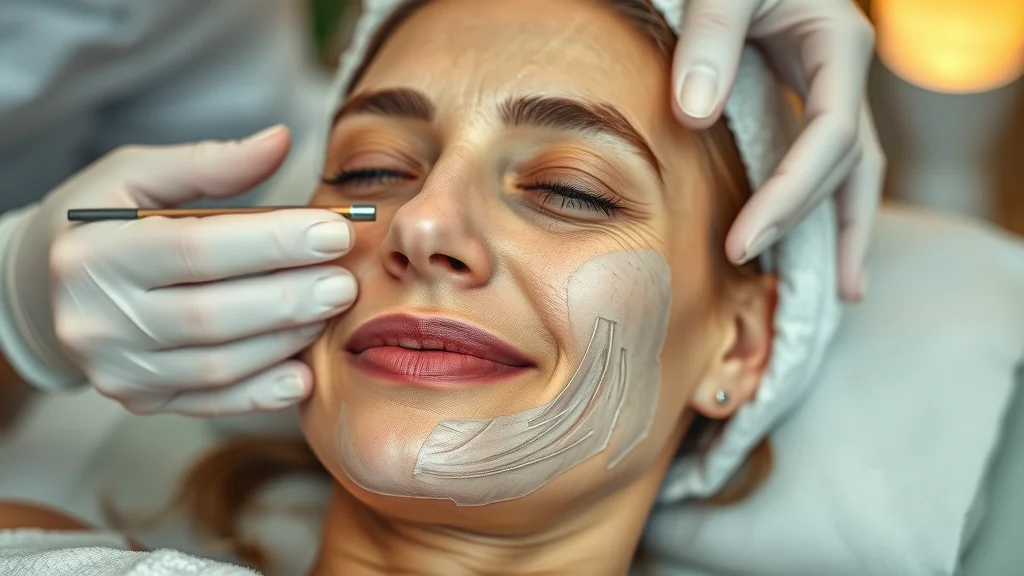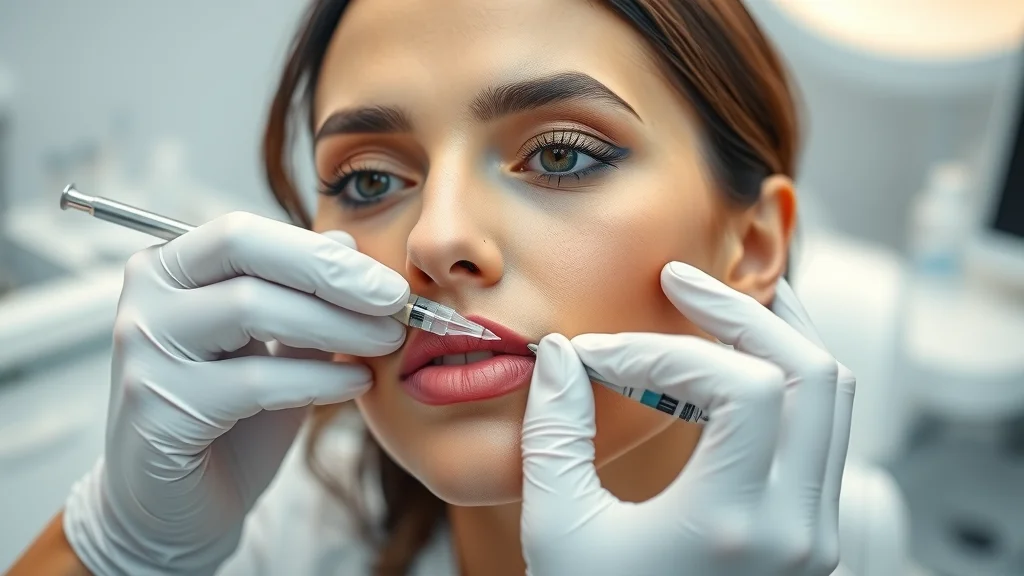Did you know? Over 13 million non-invasive skin treatments were performed last year—up 20% from the previous year, according to the American Society for Aesthetic Plastic Surgery. This explosive growth means more people are seeking youthful, refreshed skin without the downtime and risks of surgery. But rapid popularity brings new dangers: unqualified providers, misunderstood risks, and disappointing results. This guide arms you with expert insights, helping you avoid disaster and achieve safe, beautiful results from non-invasive procedures.
Startling Statistics: The Rapid Rise of Non-Invasive Skin Treatments
"Over 13 million non-invasive skin treatments were performed last year—up 20% from the previous year, according to the American Society for Aesthetic Plastic Surgery."
The demand for non-invasive skin treatments like chemical peels, laser skin resurfacing, and hyaluronic acid fillers has soared in recent years. People are opting for these innovative solutions to reduce signs of aging, improve skin tone and texture, and address issues such as fine lines, sun damage, and sagging skin—without undergoing plastic surgery or lengthy invasive procedures. This rise signals a shift towards accessible beauty, but it also emphasizes the need for safety and awareness, as more clinics and practitioners enter the market.
With millions choosing non-invasive options annually, consumers must be cautious. The ease and promise of quick improvements sometimes attract those hoping for miracle changes or overlook the essential factors like provider credentials and treatment suitability. Understanding the differences between non-invasive skin treatments and traditional approaches like plastic surgery is crucial. In this comprehensive guide, we’ll walk you through what you must know to make safe, informed decisions for your skin’s health and beauty.

What You'll Learn About Non-Invasive Skin Treatments
Key differences between non-invasive skin treatments and invasive procedures
Popular options such as chemical peel, laser skin resurfacing, and hyaluronic acid fillers
Facial rejuvenation benefits and risks
How to avoid common pitfalls
Expert insights for choosing safe non-invasive skin treatments
Understanding Non-Invasive Skin Treatments vs. Invasive Procedures
What Are Non-Invasive Skin Treatments?
Non-invasive skin treatments refer to procedures that rejuvenate or improve the appearance of the skin without surgery or significant disruption to the skin’s surface. These treatments generally rely on advanced technologies or topical agents—such as chemical peels, laser skin resurfacing, intense pulsed light (IPL), and injectable options like hyaluronic acid fillers—to target cosmetic concerns. Unlike invasive procedures that require incisions, anesthesia, or significant downtime, non-invasive options are performed in-office, have minimal recovery time, and prioritize safety and patient comfort.
People choose non-invasive approaches to tackle uneven skin tone, fine lines, mild sagging skin, and damaged skin caused by aging or sun exposure. By stimulating the body’s natural production of collagen and elastin, improving tone and texture, and smoothing out lines and wrinkles, these treatments can help achieve a more youthful appearance without the risks associated with plastic surgery. However, results are often more subtle compared to invasive facial procedures, requiring repeated sessions for optimal effect.

Non-Invasive vs. Invasive Facial Procedures: Key Differences
The primary distinction between non-invasive skin treatments and invasive facial procedures lies in the approach, recovery, and risk level. Invasive facial procedures, such as plastic surgery or deep chemical peels, physically alter tissue, involve anesthesia, and carry higher risks of complications like infection or scarring. They usually offer dramatic, longer-lasting change but require a significant recovery period.
By contrast, non-invasive treatments leverage advanced techniques—like laser therapy, gentle acids (including hydroxy acids), and injectable fillers—without the need for surgery. These procedures deliver visible improvements in skin tone, reduce signs of aging, and restore a youthful appearance with fewer complications. However, their results may be more gradual and temporary, and regular maintenance is often required. Understanding these key differences helps set realistic expectations and guides your choice depending on your cosmetic goals, lifestyle, and willingness to accept downtime or risk.
Comparing Non-Invasive Skin Treatments and Plastic Surgery
When weighing non-invasive skin treatments against traditional plastic surgery, it’s essential to consider the pros and cons of each approach. Plastic surgery offers a powerful solution for advanced signs of aging, marked sagging, or major changes in facial structure. In contrast, non-invasive options are ideal for early-to-moderate cosmetic concerns like uneven skin tone, fine lines, and mild texture issues. These treatments also appeal to those seeking quick enhancement, minimal risk, and rapid return to work or social activities.
Choosing the best approach hinges on your desired results, medical history, and comfort with risk. For some, a combination of both surgical and non-surgical options delivers the most natural outcome. Always consult a board-certified dermatologist or plastic surgeon when considering your options to ensure you receive individualized advice.
Comparison of Non-Invasive Skin Treatments vs. Invasive Facial Procedures | ||
Feature |
Non-Invasive Skin Treatments |
Invasive Facial Procedures |
|---|---|---|
Pain |
Mild discomfort, typically managed with topical anesthesia |
Moderate to severe pain, requires general/local anesthesia |
Downtime |
Little to none; quick recovery |
Extended recovery (days to weeks) |
Cost |
Lower cost per session; might require multiple sessions |
Higher one-time cost |
Longevity |
Temporary improvements (months to a couple years) |
Long-lasting or permanent results |
Risks |
Minimal, but not risk-free |
Greater potential for serious complications (infection, scarring, anesthesia) |
Types of Non-Invasive Skin Treatments: Chemical Peel, Laser Skin Resurfacing, and More
Chemical Peel and Chemical Peels for Facial Rejuvenation
Chemical peels are classic non-invasive skin treatments that exfoliate and renew the skin by applying a specialized solution—often containing alpha hydroxy acids, beta hydroxy acids, or blended agents. They help address uneven skin tone, superficial lines and wrinkles, and pigmentation issues caused by aging or environmental exposure. Depending on the depth, chemical peels can leave your skin looking brighter, smoother, and more radiant, with minimal downtime for mild peels.
For facial rejuvenation, chemical peels provide a cost-effective way to “reset” the skin’s surface. Light and medium-depth peels are suitable for most skin types and require only minor aftercare, such as moisturizing and sun avoidance. Deeper peels create more dramatic change but can carry extra risks and a more prolonged recovery. Consulting a qualified practitioner ensures the technique and acid concentration are tailored to your unique needs and skin sensitivities, minimizing potential for damaged skin or discoloration.

Laser Skin Resurfacing and Intense Pulsed Light (IPL) Explained
Laser skin resurfacing and intense pulsed light (IPL) treatments use advanced energy-based technology to target signs of aging, sun damage, and uneven skin texture. These procedures stimulate the natural production of collagen and elastin, leading to smoother, firmer, and younger-looking skin. Laser skin resurfacing is ideal for treating fine lines, acne scars, and areas of damaged skin, while IPL is excellent for reducing redness, broken capillaries, and pigmentation issues.
Both options offer customizable energy settings and minimal downtime. Patients typically experience redness and swelling that resolves within a few days, and benefits can be seen within a few weeks. Proper aftercare—including sun protection and gentle cleansing—helps prolong the effects and minimizes risks like irritation or uneven healing. Always ensure the provider is experienced in energy-based cosmetic procedures to maximize patient satisfaction and safety.
Hyaluronic Acid Fillers and Injectable Non-Invasive Solutions
Hyaluronic acid fillers are leading injectables used for subtle volume enhancement, contouring, and smoothing of fine lines. These dermal fillers work by attracting and retaining moisture within skin tissues, resulting in immediate improvement of facial contours, lips, and undereye hollows without the invasiveness of surgery or implants. Other injectable non-invasive solutions might include wrinkle relaxers or biostimulatory agents, which further contribute to facial rejuvenation.
Effects from hyaluronic acid products develop instantly and last from six months to two years, depending on the area treated and filler composition. When performed by skilled clinicians, risks are minimal, but improper technique or non-medical providers can result in bruising, asymmetry, or, in rare cases, severe complications. Always confirm the dermal filler used is FDA-approved and that the provider is trained in aesthetic medicine.

Other Popular Non-Invasive Skin Treatments and Their Benefits
Beyond chemical peels, laser, and injectables, additional non-invasive skin treatments include microdermabrasion, microneedling, radiofrequency (RF) therapy, and ultrasound-based tightening. Microdermabrasion polishes away surface imperfections using mild abrasion, while microneedling creates tiny channels in the skin to stimulate healing. RF and ultrasound-based devices heat underlying tissues, leading to gradual skin tightening and improved elasticity.
These techniques can effectively address early signs of aging, damaged skin, and tone and texture irregularities. Typically, these procedures offer minimal discomfort and a short recovery timeframe, making them popular among busy professionals and those seeking subtle, safe enhancements. As with all non-invasive cosmetic procedures, proper consultation and personalization are the keys to maximizing benefits while limiting risks.
Facial Rejuvenation: Results, Longevity, and Safety Concerns
Expected Results from Non-Invasive Skin Treatments
Realistic expectations are vital for anyone considering non-invasive skin treatments for facial rejuvenation. Results often become noticeable within a few days to weeks, depending on the type of procedure and your skin’s healing response. For example, a chemical peel or laser skin resurfacing may deliver brighter, clearer skin in under two weeks, while hyaluronic acid fillers create an immediate plumping effect.
Most patients find improvements in skin tone, smoother skin texture, and a reduction of fine lines and surface imperfections. These treatments work best for mild to moderate issues, enhancing overall appearance without fundamentally changing facial structure. For best results, follow your provider’s aftercare advice and consider regular maintenance sessions to preserve your youthful glow.

Longevity: How Long Do Non-Invasive Skin Treatments Last?
The duration of results from non-invasive skin treatments varies widely based on treatment type, the area addressed, your age, and your skin’s unique characteristics. Mild chemical peels and light resurfacing may last a few months, while deeper peels, laser skin resurfacing, and injectable fillers can offer visible benefits for up to a year or longer. Maintenance treatments are often required to retain optimal results, especially as natural aging continues to affect your skin’s collagen and elastin production.
Combining multiple modalities (such as peels and energy-based therapies) can sometimes enhance longevity, especially when performed by an experienced provider. Discuss your lifestyle, skincare routine, and cosmetic goals with a specialist to develop a realistic plan for maintenance and long-term satisfaction with your non-invasive treatments.
Risks and Safety: Avoiding Treatment Disasters
Despite being considered safer than invasive facial procedures, non-invasive skin solutions are not entirely without risk. Complications may range from temporary redness and swelling to more serious outcomes like hyperpigmentation, infection, or tissue injury—particularly when performed by unlicensed or inadequately trained practitioners. Patient satisfaction and safety depend on rigorous hygiene, accurate diagnosis, and the use of safe, approved products and devices.
To minimize the chance of mishaps, always:
Vet your provider’s credentials and experience with your chosen treatment
Understand possible side effects and what to expect during recovery
Follow all pre- and post-treatment care instructions
Report any unusual pain, discoloration, or delayed healing immediately
non-invasive skin treatments
"Patients should always confirm a provider's credentials and understand the risks associated with even the safest non-invasive treatments." – Dr. Emily Reese, Dermatologist
How to Choose Safe and Effective Non-Invasive Skin Treatments

-
Checklist: Key questions to ask your practitioner
Are you board-certified in dermatology or cosmetic medicine?
What experience do you have with this specific non-invasive procedure?
Which products or devices will you use for my treatment?
What are the expected outcomes and recovery details?
How do you manage side effects or complications?
-
Certifications and clinic safety standards
Look for clinics with visible licensing, up-to-date device certifications, and adherence to safety standards.
Ensure providers regularly attend professional training and use FDA-approved products.
-
Warning signs of poor-quality non-invasive treatments
Too-good-to-be-true pricing or package deals
Lack of initial consultation or brief medical screening
Poor hygiene or unprofessional environment
Pressure selling or discouraging questions
People Also Ask: Common Questions About Non-Invasive Skin Treatments
Is there a non-invasive way to tighten skin?
Yes—modern treatments like radiofrequency (RF) therapy, ultrasound-based devices, and some laser skin resurfacing methods can effectively tighten lax or mildly sagging skin without surgery. These procedures deliver targeted energy below the skin’s surface, prompting collagen and elastin regeneration. Results are typically gradual, developing over several months, but can noticeably improve jawline definition and reduce mild jowling when performed by a skilled practitioner. Combining these methods with other non-invasive skin treatments may provide even greater improvement for those looking to avoid plastic surgery.
How long does non-invasive skin tightening last?
The longevity of non-invasive skin tightening procedures varies based on the device, treatment intensity, and your individual skin type. Most patients enjoy results for six months to two years before a touch-up is recommended. Factors like age, lifestyle, sun exposure, and aftercare can influence how long the effects last. Routine maintenance appointments with your provider will help sustain a firmer, more youthful appearance over time, without needing invasive facial procedures or plastic surgery.
What is the invisible facelift that's better than fillers?
The term “invisible facelift” often refers to advanced non-invasive skin tightening procedures combining radiofrequency, ultrasound, and sometimes laser therapy to lift and rejuvenate facial structures below the surface. Unlike traditional injectable fillers that physically add volume, these non-invasive modalities stimulate your skin’s natural rebuilding processes, delivering more gradual, natural-looking improvements to skin tone, flexibility, and contour. Such methods are suitable for those who desire subtle lift and facial rejuvenation without altering facial fullness.
What is the newest skin tightening procedure?
One of the latest innovations in non-invasive skin tightening is the use of advanced microfocused ultrasound combined with high-frequency radiofrequency (such as in Ultherapy or Thermage). These technologies precisely target deeper skin layers, prompting robust collagen and elastin production for firmer, tighter, and more youthful-looking skin. They are popular for their minimal downtime, safety on all skin tones, and suitability for patients looking to stave off more invasive cosmetic procedures.
These answers are evidence-based and leverage modern advances in non-invasive skin treatments, covering chemical peels, laser skin resurfacing, intense pulsed light, and hyaluronic acid use.
FAQs: Non-Invasive Skin Treatments
Can non-invasive skin treatments replace plastic surgery?
Non-invasive treatments cannot fully replace the transformative effects of plastic surgery, particularly for significant sagging or advanced signs of aging. However, for mild to moderate concerns, they offer meaningful improvement in skin tone, texture, and contour, often delaying the need for invasive facial procedures.Are non-invasive treatments suitable for all skin types?
Most non-invasive solutions such as chemical peels, laser skin resurfacing, and fillers are safe for diverse skin types, but procedure selection, energy level, and product type must be tailored to your individual needs. Always discuss your medical history and skin sensitivities with your provider beforehand.What is the recovery time compared to invasive procedures?
Non-invasive skin treatments typically offer minimal to no recovery time. Most patients return to daily routines soon after treatment. In contrast, invasive procedures like plastic surgery may require days to weeks of downtime for healing and post-operative care.Do non-invasive skin treatments have side effects?
Minor side effects like temporary redness, swelling, or mild irritation are common and generally resolve quickly. More severe complications are rare but can include infection, hyperpigmentation, or allergic reactions, especially if treatments are performed by unqualified individuals.
Key Takeaways: Avoiding Disaster with Non-Invasive Skin Treatments
Careful research prevents unwanted side effects.
Not all clinics are created equal—select certified, experienced providers.
Know the difference between invasive and non-invasive treatments to set realistic expectations.
Always consult board-certified professionals before undergoing non-invasive skin procedures.
Final Thoughts: Achieving Safe and Effective Facial Rejuvenation with Non-Invasive Skin Treatments
"Non-invasive skin treatments can deliver impressive results, but safety and expertise are paramount."
With careful planning and informed choices, you can enjoy the benefits of non-invasive skin treatments without risking your health—or your beauty.
Ready to Take the Next Step? Book a Consultation with a Trusted Skin Specialist Today
Explore your non-invasive skin options with a certified dermatologist or cosmetic specialist. Investing in professional expertise is the safest way to achieve rejuvenated, healthy, glowing skin—without regret.
 Add Row
Add Row  Add
Add 




Write A Comment